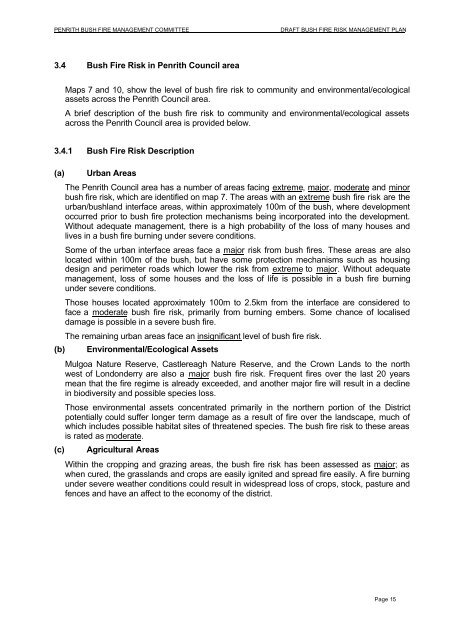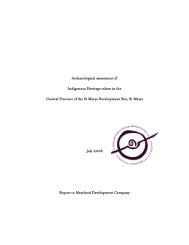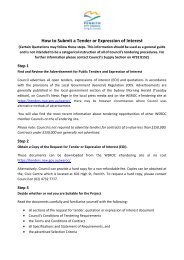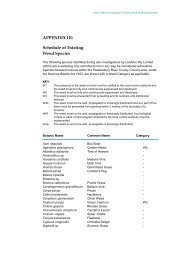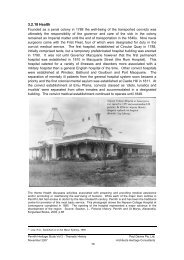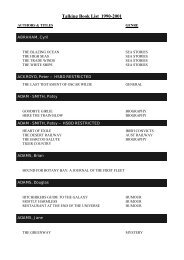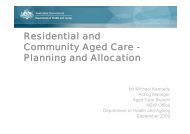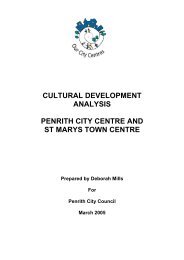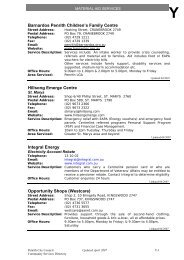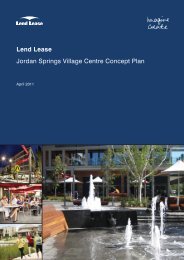Penrith Bush Fire Management Committee Bush Fire Risk ...
Penrith Bush Fire Management Committee Bush Fire Risk ...
Penrith Bush Fire Management Committee Bush Fire Risk ...
Create successful ePaper yourself
Turn your PDF publications into a flip-book with our unique Google optimized e-Paper software.
PENRITH BUSH FIRE MANAGEMENT COMMITTEE DRAFT BUSH FIRE RISK MANAGEMENT PLAN<br />
3.4 <strong>Bush</strong> <strong>Fire</strong> <strong>Risk</strong> in <strong>Penrith</strong> Council area<br />
Maps 7 and 10, show the level of bush fire risk to community and environmental/ecological<br />
assets across the <strong>Penrith</strong> Council area.<br />
A brief description of the bush fire risk to community and environmental/ecological assets<br />
across the <strong>Penrith</strong> Council area is provided below.<br />
3.4.1 <strong>Bush</strong> <strong>Fire</strong> <strong>Risk</strong> Description<br />
(a) Urban Areas<br />
The <strong>Penrith</strong> Council area has a number of areas facing extreme, major, moderate and minor<br />
bush fire risk, which are identified on map 7. The areas with an extreme bush fire risk are the<br />
urban/bushland interface areas, within approximately 100m of the bush, where development<br />
occurred prior to bush fire protection mechanisms being incorporated into the development.<br />
Without adequate management, there is a high probability of the loss of many houses and<br />
lives in a bush fire burning under severe conditions.<br />
Some of the urban interface areas face a major risk from bush fires. These areas are also<br />
located within 100m of the bush, but have some protection mechanisms such as housing<br />
design and perimeter roads which lower the risk from extreme to major. Without adequate<br />
management, loss of some houses and the loss of life is possible in a bush fire burning<br />
under severe conditions.<br />
Those houses located approximately 100m to 2.5km from the interface are considered to<br />
face a moderate bush fire risk, primarily from burning embers. Some chance of localised<br />
damage is possible in a severe bush fire.<br />
The remaining urban areas face an insignificant level of bush fire risk.<br />
(b) Environmental/Ecological Assets<br />
Mulgoa Nature Reserve, Castlereagh Nature Reserve, and the Crown Lands to the north<br />
west of Londonderry are also a major bush fire risk. Frequent fires over the last 20 years<br />
mean that the fire regime is already exceeded, and another major fire will result in a decline<br />
in biodiversity and possible species loss.<br />
Those environmental assets concentrated primarily in the northern portion of the District<br />
potentially could suffer longer term damage as a result of fire over the landscape, much of<br />
which includes possible habitat sites of threatened species. The bush fire risk to these areas<br />
is rated as moderate.<br />
(c) Agricultural Areas<br />
Within the cropping and grazing areas, the bush fire risk has been assessed as major; as<br />
when cured, the grasslands and crops are easily ignited and spread fire easily. A fire burning<br />
under severe weather conditions could result in widespread loss of crops, stock, pasture and<br />
fences and have an affect to the economy of the district.<br />
Page 15


